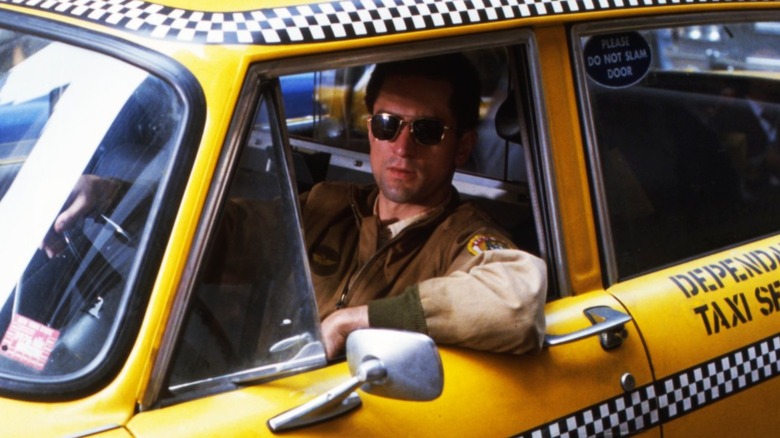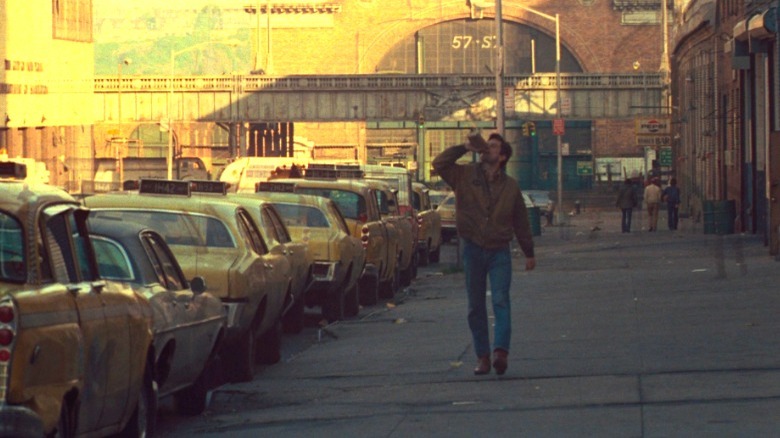Taxi Driver's Tight Budget Was A Blessing In Disguise
"Taxi Driver" brought the notoriously grimy streets of New York City in the 1970s to the big screen. Sure, previous films like "The French Connection" and "Death Wish" explored the city's thriving underbelly, but director Martin Scorsese made New York feel like a character of itself, a place where residents melded with their decaying home whether they wanted to or not. Scorsese and cinematographer Michael Chapman shot the grit and sleaze in a matter-of-fact, documentary-like style, lending the scenery a sense of authenticity. That might have not all been intentional, though, since the signature seedy look of "Taxi Driver" was at least partially due to the film's ultra low budget.
A retrospective published by The Hollywood Reporter in 2016 tells of how producers Michael and Julia Phillips acquired Paul Schrader's script years before production began but were unable to figure out who could bring such a dark, psychologically complex story to the screen. Scorsese wanted to take on the project the moment he first read the script after director Brian De Palma showed it to him, but it wasn't until the Phillipses saw "Mean Streets" that they were convinced of his capability. More importantly, Scorsese was so eager to helm "Taxi Driver" that he was totally willing to work with a $1.9 price tag, which minimized the financial risk for Columbia Pictures and allowed him a higher degree of creative freedom. In order to keep the film under budget, Scorsese and the actors in the film took significant pay cuts, including the recently Oscar-winning Robert De Niro. Clearly, "Taxi Driver" was a passion project, not a business assignment.
Documenting New York
"Taxi Driver" was shot in New York's notorious summer of 1975, when the city filed for bankruptcy and its crumbling economy reached a new low. This was the same time as when the infamous newspaper headline "Ford to City: Drop Dead" was published in response to a rejected federal bailout, and when police and firefighters were nicknaming the place "Fear City." Scorsese and the crew managed to catch a sanitation workers' strike in the midst of a heatwave, too, meaning that all that dirt and grime was authentic. The crew had no money for set lighting, so they had to rely on whatever "natural" light New York could give them. Michael Chapman stated in THR that this, in fact, enhanced the visual language of the film:
"Much of the way the movie looks was dictated by the fact that we didn't have a lot of time and didn't have a lot of money and therefore couldn't do traditional things. We couldn't light the streets with big lights. We had to take our level of light down to let New York light itself. Of course, that turned out to be exactly the right thing to do, and I was eager to do it in a terrified sort of way. Thank God we didn't have anymore time or money."
Budgetary restraints influenced much of the film's raw, cinéma vérité look. The taxi-driving scenes were really just Robert De Niro driving an actual New York cab while Scorsese, Chapman, and the cameraman hid in the back seat and the person manning the sound squeezed in the trunk. According to Michael Phillips, they also built sets in condemned buildings and had to hire gangs to protect them. The outside environment influenced the shoot so much that a days-long rain spout delayed the production's already tight schedule. Nevertheless, the end result is one of the most influential pieces of low-budget filmmaking ever, no doubt due to how real the constraints make New York City feel.

